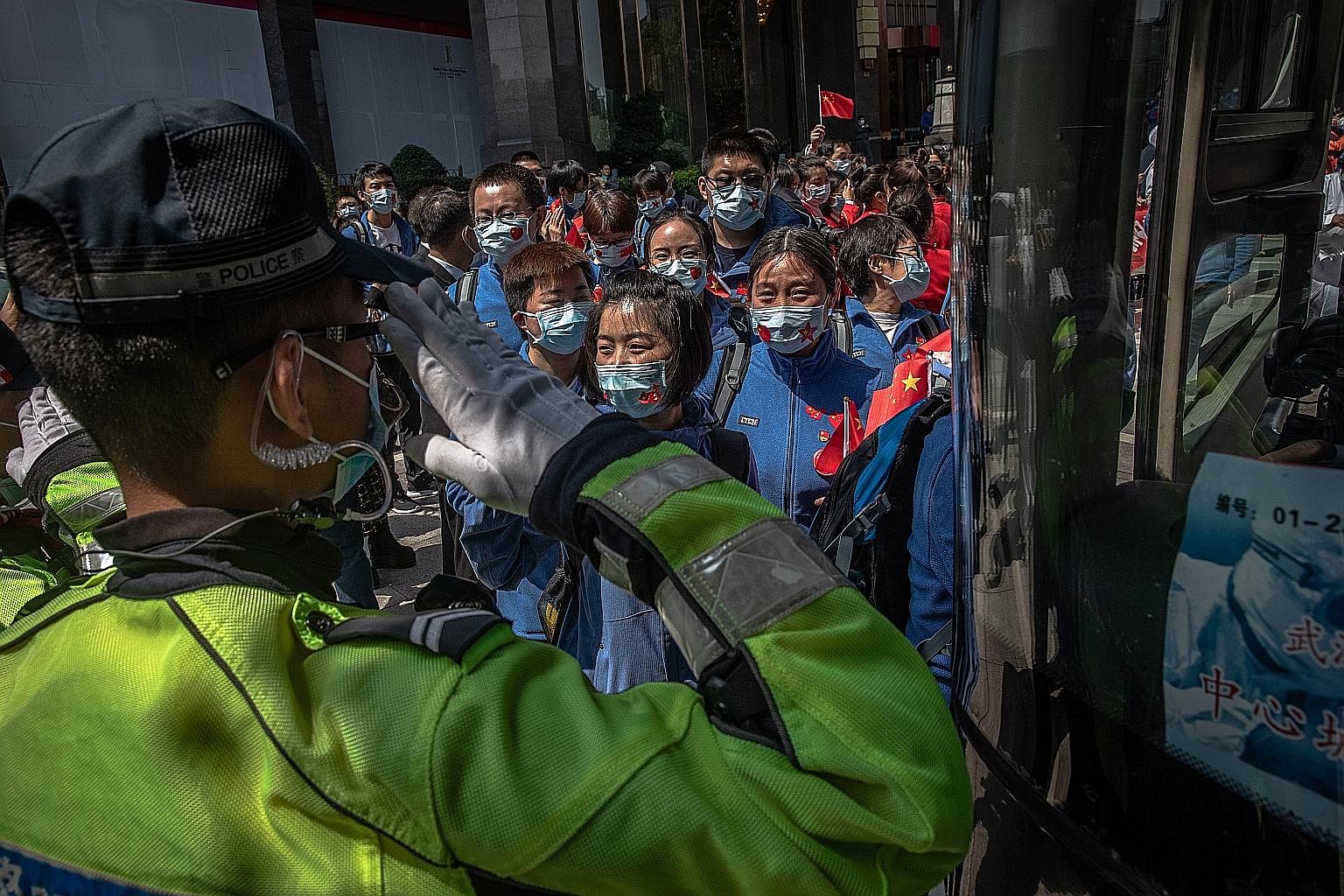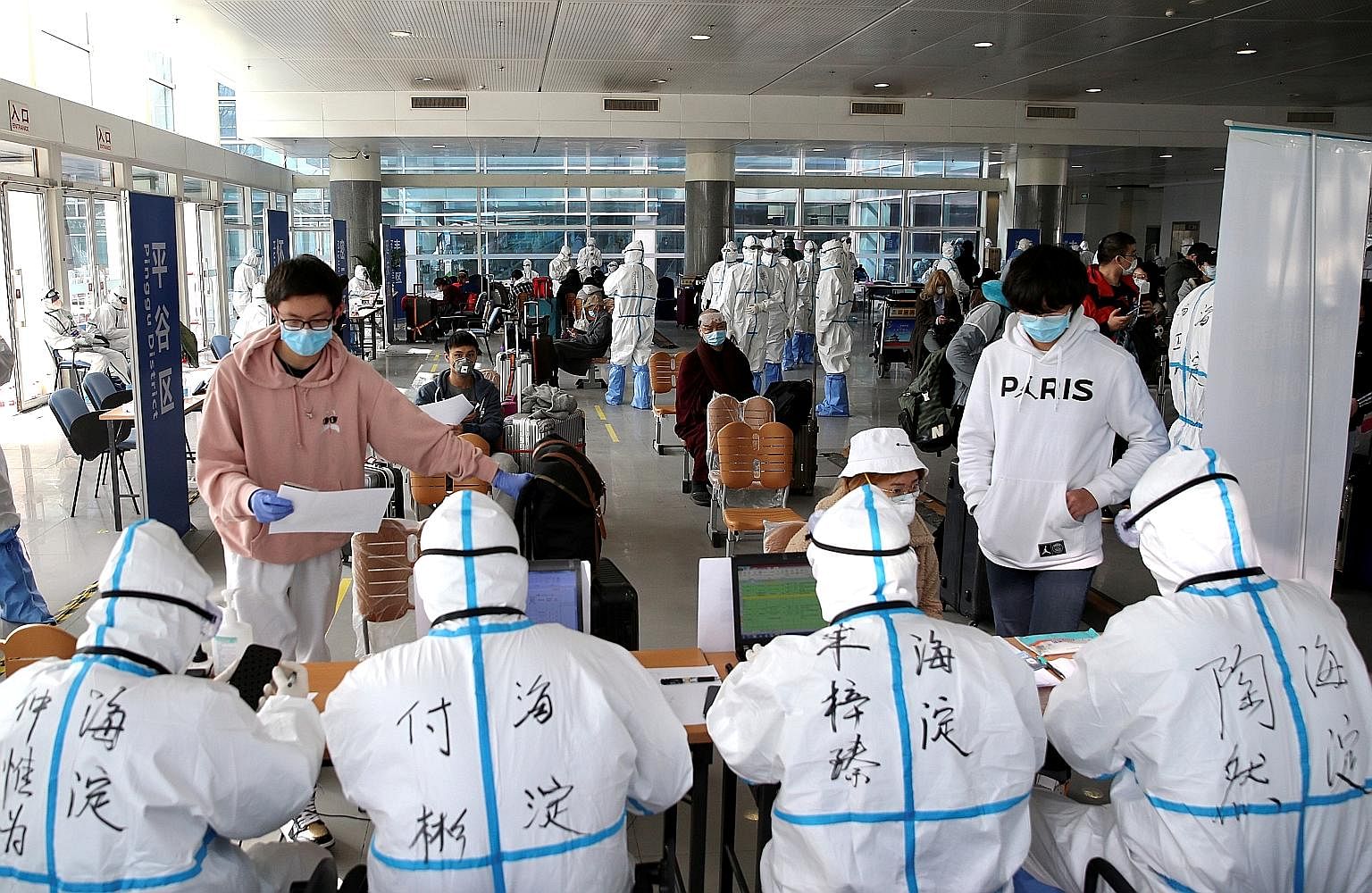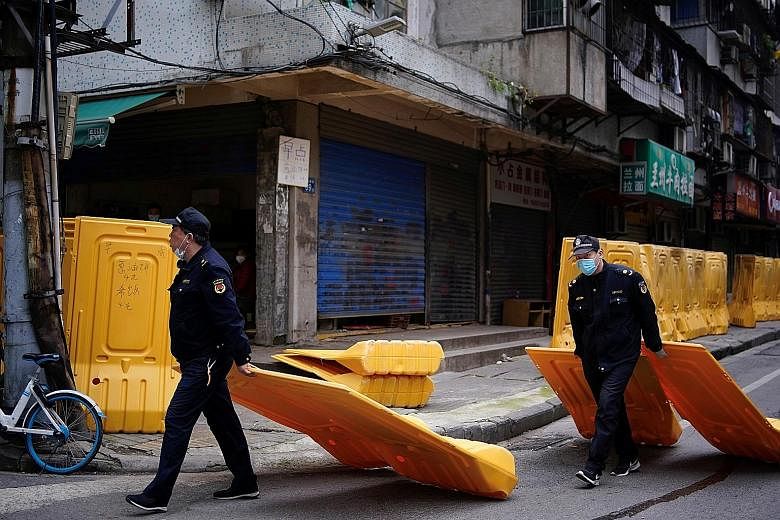BEIJING • As China cautiously loosened the lockdown for people to return to work and shops to re-open last month, Ms Yuan Shaomin heaved a sigh of relief.
Her three beauty salons had been shut for two months while she continued paying her 20 employees their wages plus social insurance. Thankfully, the landlords of two of her shops gave her one month's rebate on her rent that amounted to 45,000 yuan (S$9,200).
"This is the worst crisis I've faced in my business in all 16 years," said Ms Yuan, 42, who is from Beijing.
She said she has chalked up losses of about 1.5 million yuan. And even after her shops re-opened on March 21, only half of her employees have come in for work as she gets just one or two customers a day; sometimes none.
"I can sustain the business till the end of May. I just hope the economy picks up soon," said Ms Yuan, who has now started offering beauty classes online.
"Everything has a beginning, a journey and an end. This epidemic will pass," she added.
As the rest of the world grapples with runaway numbers of infections, a woeful shortage of beds and test kits, while ordering cities into lockdown, China seems to be emerging near the end of the tunnel with light in sight.
Face masks are readily available in brick-and-mortar shops as well as e-commerce platforms such as Taobao and Jingdong when they were nowhere to be found at the height of the epidemic in late January and early February.
The 16 temporary treatment centres that sprang up overnight in Wuhan have all shut, and thousands of medical workers and People's Liberation Army medics who were deployed to the epicentre of the outbreak have gone home.
Today, Wuhan lifts its lockdown, allowing residents who have been sealed in since Jan 23 to leave the city. Its international airport, shut for more than two months, has also re-opened.
NOT OUT OF THE WOODS
But even as it loosens the reins on the epicentre of the outbreak, China has now found itself teetering on the brink of a possible second wave of infection.
For the first time since the outbreak, the National Health Commission yesterday reported no new deaths in Wuhan, although the number of infected travellers entering China continues to grow. Some of them have also spread the disease.
By yesterday, the number of imported cases stood at 983, while the overall number of people infected hit 81,740.
-
STARK NUMBERS
-
81,740
Total number of infections in mainland China as at Monday.
-
3,331
Total number of deaths.
The health authorities had previously said that 90 per cent of the imported cases came from Chinese students and expatriates who are flocking home to escape the outbreak in other parts of the world.
To curb such inbound infections, the authorities in major air hubs such as Beijing, Shanghai and Guangzhou got tougher incrementally, starting by requiring all incoming travellers to serve a 14-day quarantine, then mandating the isolation be in centralised facilities.
Travellers then had to be tested for the coronavirus.
Beijing, which had borne the brunt of the imported cases, started diverting planes to other cities for passengers to be screened before they could make their way to the capital city.
More than a week ago, China essentially shut its borders by barring foreigners from entering, including those who have visas or are residents. It also cancelled a swathe of international flights, restricting each airline to operating just one route once a week.
Even so, there are still hundreds of thousands of Chinese nationals who want to go home. On Monday, the authorities, after discouraging them from returning for fear of being unable to cope with another wave of infections, relented by announcing it is planning to charter planes to repatriate Chinese students in the United States.
According to the Chinese Embassy in Washington, 90 per cent of the 400,000 Chinese students in the United States remain in the country.
As China tackles this influx, it has at the same time had to deal with intensifying scrutiny over the rise in the number of asymptomatic cases.
Last week, a county in central China was put under lockdown again after it emerged that a woman had fallen sick from being infected by a doctor friend who had not displayed any symptoms of the disease.

Jia county, which has a population of 640,000, tested medical workers and found that three doctors, including this asymptomatic physician, all had the virus even though they did not appear sick.
The health authorities bowed to public pressure and are now disclosing the number of asymptomatic cases in the country in its daily report since last week.
There has been an average of 66 new cases of asymptomatic cases reported a day since the National Health Commission began releasing the figures from April 1, and more than 1,000 asymptomatic cases under medical observation, says the health commission.
But these cases are still not counted in the official tally unless they develop symptoms and are re-classified as confirmed cases.
"It's unclear how many 'asymptomatic' patients are actually 'presymptomatic', that is, they go on to develop symptoms after the test was taken. And since we know both asymptomatic and presymptomatic cases do contribute to transmission of Covid-19, I personally don't understand why they should be accounted separately," said Professor Babak Javid, an infectious disease expert at Tsinghua University n Beijing.
"Having a more complete picture of the full spectrum of cases is more, not less, helpful."
Making these numbers public has also not assuaged the fear among the Chinese that these silent carriers will start spreading the virus, now that travel restrictions around the country are easing
"They say these asymptomatic people are less contagious, but they are still capable of infecting others. And I think they're scarier because you don't know if they might be sitting next to you on the subway, or they could be your colleagues at work or even your friends," said accounts assistant Zhang Xuan, 30, who works in Beijing.
"This unknown is the most worrisome."
STRIKING A DELICATE BALANCE
Last week, in a symbolic visit to Zhejiang - dubbed the "backbone of China" for its role as a key economic driver - President Xi Jinping urged the country to stay vigilant in keeping the virus at bay, even as it tries to get its lagging economy back on track.
"We must specifically strengthen our work to manage asymptomatic cases and impose suitable precautionary measures on all areas of business recovery and social life," the official news agency Xinhua quoted him as saying. President Xi also said Beijing would make curbing imported cases its top priority "for the time being and maybe for a long period of time".
Commentators noted that television footage and photos showed Mr Xi and other senior officials doing their inspection rounds outdoors without wearing masks, a signal of confidence that life should return to normalcy.

This is the dilemma and challenge confronting China now: how to strike that delicate balance between jump-starting its stalled economy while keeping a lid on infections that are still popping up every day.
Last week, the World Bank forecast that China's growth would slow to 2.3 per cent in the baseline scenario, or as low as 0.1 per cent in the worst-case scenario, compared with growth of 6.1 per cent last year.
Just before the outbreak, economists at the World Bank had projected a 5.9 per cent growth for China this year.
A two-month shutdown has also brought on double-digit percentage dips across factory output, retail sales and construction, while urban unemployment hit a record high of 6.2 per cent in February.
Economist Tommy Xie of OCBC Bank said China's growth figure this year will depend on two factors: when the global lockdown is lifted and whether China will face yet another wave of infections.
"It seems China is behind the curve in terms of stimulus. But in the past two weeks, we have started to see China step up its efforts from both monetary and fiscal sides," said Mr Xie.
Its central bank announced last week it would cut the reserve requirement ratio for the third time this year, injecting 400 billion yuan to shore up the economy. On the fiscal front, it is increasing its fiscal deficit target, and letting local governments sell more infrastructure bonds to boost investment.
But its near-term challenge will be a demand shock, which could be "more detrimental to job stability as compared to the supply shock we saw in February", said Mr Xie.
"I expect the unemployment rate to rise further, which may require more intervention from government."
The immediate danger facing China now is the possibility of a resurgence of infections, likely to be caused by the imported cases.
China had earlier rejected the "herd immunity" approach proposed by the Dutch and the British, favouring uncompromising lockdowns and hard social distancing.
But Dr Huang Yanzhong, a senior fellow for global health at the Council on Foreign Relations, said that all provinces other than Hubei have not had the opportunity to be exposed to the virus because of the government's draconian measures.
"This actually forms an immunity gap - a differential in immunity which poses a real threat to Beijing's effort to sustain its achievement," said Dr Huang, who is also a professor at Seton Hall University's School of Diplomacy and International Relations.
"China could certainly claim it has the situation under control, but the stability and achievement are still very fragile. Without sustained and even strengthened containment measures, there are chances it might face a resurgence of outbreak and that remains a major concern."
HEALTHCARE SYSTEM PRAISED
Wuhan native Ding Hui, 40, has spent a good part of the past two months in hospital and then under quarantine at a hotel after he contracted the coronavirus in late January.
He is now doing a second round of quarantine at home with his pregnant wife, who also became infected.
"From the lack of experience dealing with the outbreak in the early days to adjustments to their measures along the way, I've seen an obvious improvement," said the university computer science lecturer.
"If I have to evaluate the treatment we've received this entire time, I'd say I'm very grateful to the country for providing free treatment for coronavirus patients, and I'm very grateful to the medical workers."












